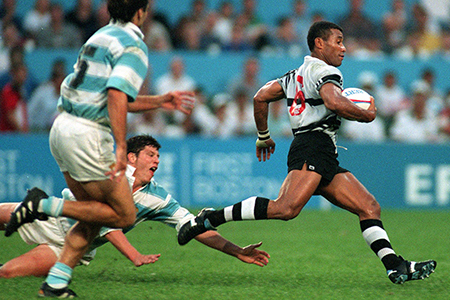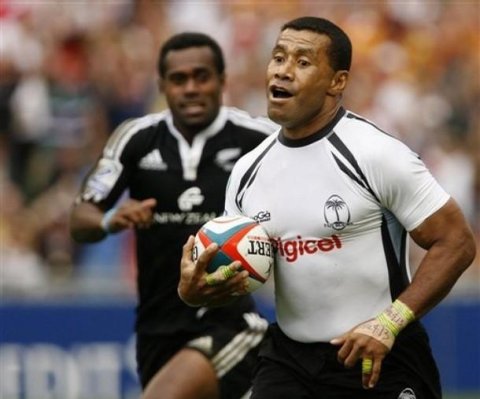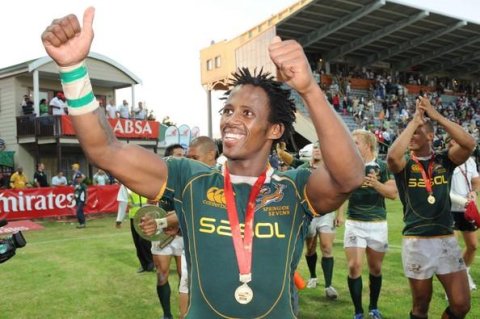Sevens is a game that one can play in any position with reasonable success at the lower levels, but as you progress it becomes a lot more specialized. Some items here are also found in my previous articles on playing prop in sevens, playing hooker in sevens, and playing scrumhalf in sevens, but are important if reading this piece by itself.

What is required to play flyhalf?
Generally a flyhalf (like the scrumhalf) is one of the most skilful players on the field. Passing well off both hands, excellent vision and decision-making, kicking in open play, and for points are all vital attributes. Speed (off the mark) and fitness are essential. The flyhalf could be a flyhalf, scrumhalf or center in XVs rugby. Obviously many of these statements are generalizations, but based on my own experience in sevens.
Kickoffs kicked: Often the kicker in the team is the flyhalf, who will then drop back to play sweeper after the kick is taken. The flyhalf doesn’t have to be the sweeper off the restart, as long as this is communicated to the person who will be covering that position. We will go over the role of the sweeper in more detail via another article.
If the flyhalf isn’t sweeping, he/she must stay in the same defensive line as the rest of the team when the ball is kicked.
There are two types of kickoffs: one in which the team attempts to retain possession, and the other in which defensive pressure creates opportunities. To win kickoff restarts, which is the highest occurring set piece in sevens, the team that kicks off must leave the ball in the air for as long as possible. England’s Ben Gollings is one of the masters of the game who can execute a perfect kickoff for his team’s forwards to win the ball in the air. He is generally aiming to leave the ball between the 10m and 22m (the goal is around 10-15m), with his forwards either tapping the ball back or catching it cleanly in the air.

The most famous sevens player of all time – Waisale Serevi (pictured above) – is also this accurate when it comes to kickoffs. Watch how vital his restart is during the 2006 Hong Kong IRB Sevens final. Fiji is able to retain possession and score the winning try through youngster William Ryder.
Samoa and Fiji have mixed things up on occasions with the same style kick, but sending it directly into the center of the field, just past the 10m mark. This tactic caught teams off guard, who only really had one defender attempting to catch this kickoff, plus they are standing still and struggle to get height in the aerial battle.
The clip below is taken from the 2007 Hong Kong IRB Sevens final, which is one of the greatest finals of all time. I was fortunate to play for the USA during that same tournament and we watched this final live, witnessing two of the best halves played by Samoa and Fiji, with all the points scored on our side of the field.
Fiji vs Samoa, Hong Kong 2007.Watch video.
Watch Samoa’s scrumhalf Uale Mai kickoff during 1 minutes 2 seconds in the clip. The ball doesn’t travel 10m but Fiji touch it, so Samoa manage to retain the ball.
Then watch the next kickoff by Mai at 3 minutes 8 seconds: this time it goes deeper than 10m and Samoa retain possession – scoring straight from it. Fiji has not touched the ball and is down 12-0, all thanks to the excellent restarts.
Mai’s third kick-off is another outstanding effort (4 minutes 30 seconds), as his forwards slap it backwards, retaining yet another vital restart. Several passages of play later and Mikaele Pesamino scores his team’s third try.
In the same clip see Mai’s fourth kick-off at 9 minutes 15 seconds, which is again slapped back towards his side, retaining yet another vital possession. The first half is a perfect example of complete dominance from Samoa. In defense it is so difficult to receive that kickoff while standing still, as the opposition sprint through gaining an aerial advantage.
In the second half, watch 16 minutes 50 seconds for one of the try saving tackles of the Series. Pesamino what a legend. The sequence that follows eats up so much time, it effectively doesn’t allow Fiji to come back and win this match.
Look at Fiji’s William Ryder kicking off at 21 minutes 54 seconds, as he puts in a huge hanging sideline kick. His forwards aren’t as fit as they should be to get under that kick and retain possession, but luckily it bounces up and Fiji still end up scoring. Ryder’s next kickoff at 23 minutes 12 seconds also sees them retain possession through an error from Samoa, and sets up a very interesting final few minutes.
New Zealand often opts to kick deep (past the 22m in the corners) until they have gained a considerable lead on teams. They don’t mind conceding possession for territory. Their defense is able to contain the attacking team, and eventually force an error or turnover. If the attackers kick the ball back, then New Zealand has a counter-attacking opportunity and regains possession.
Playing for the USA we have used this option during some very successful matches. One that comes to mind was our 24-19 win over Samoa during the George IRB Sevens in South Africa back in 2007/2008.
Kickoffs received: The flyhalf stands around the 22m area in the middle of the field when receiving a kickoff. In this way he/she can get into an attacking position once the ball is received. From there the ball can go wide, unless you are on your own tryline, and opt for a clearance kick.
Lineout’s: The role of the flyhalf is to expose the gaps in the opposition, and the lineout presents a great attacking platform with the defense an extra 10m away.
Scrums: When on attack the flyhalf often has to stand directly behind the scrum to ensure the scrumhalf is able to pass, flick or kick the ball to him/ her. During certain scrums there will be less pressure on the scrumhalf, which means the flyhalf can spread the field to create a better attacking
platform.
Fiji vs Samoa, Hong Kong 2007. Watch video.
Watch flyhalf Lolo Lui for Samoa standing directly behind the scrum during this attack (1 minute 38 seconds). The ball then goes wide and it’s the playmaking skills of Mai who sets up the first try in this classic Hong Kong final.
In the same clip at 7 minutes 48 seconds it is Lui who creates something out of nothing from a mid-field scrum by drawing William Ryder and setting his center away.
Defense: The role of the flyhalf on defense is vital as he/she is normally in the middle of the field. From set pieces the goal of the flyhalf is to force the opposition to take the ball wide, covering the inside pass. Once the ball gets to the opposition wing, the defenders can use the sideline and squeeze that runner out of bounds with all three players (wing, center and flyhalf) working together.
Attack:
The flyhalf is a creator of space, exploiting defenders and ultimately scoring or setting up tries for his/her team. Support play is vital, with the flyhalf able to get into a great position when the center or wing breaks free. Remember that the sweeper often makes an excellent tackle during the breakout, and it’s the next player in support who completes the play by taking the offload and dotting down the important 5 pointer.

Best flyhalfs in the world?
Some of my favourite flyhalfs of all time include: Fiji’s Waisale Serevi, South Africa’s Fabian Juries and Mzwandile Stick (pictured above), Samoa’s Lolo Lui and of course England’s Ben Gollings.
All of these players have superior decision-making; skill and a calmness under pressure that enables them to single handedly change the result of a match.
Conversions are also amongst the most important skill in sevens and often decide the fate of a game. The same goes for drop kicks in open play, and the rare taken penalty.
I was fortunate to kick a penalty for the USA during the George IRB Sevens and join a very small list of players that have done the same. Luckily it was right in front of the poles, and it helped us beat rivals Canada!
Watch these highlight clips to see Fiji’s Waisale Serevi (number 6) in action. Serevi is second on the all-time points table, with 1310 and is 25th on the most tries list with 79. Bear in mind he played well before the IRB World Series started, and only retired near his 37th birthday.
Watch this highlight clip to see England’s Ben Gollings (number 10) in action. Golling’s scores his 200th try at the end of this video, an unbelievable achievement. He holds the current record for the most points scored on the IRB World Series (2374 points), and is second on most tries scored (202) behind Argentina’s Santiago Gomez Cora, who has 230 tries.
Watch this highlight clip to see South Africa’s Mzwandile Stick (number 10) in action. Stick is just behind his teammate on 9th place with 855 points and is 19th on the most tries list with 86.
v
Watch this highlight clip to see Samoa’s Lolo Lui (number 7) in action. Lui is in 10th spot with 831 points and has plenty of rugby left in him.
Are you a flyhalf?
Superior decision-making and vision; accurate passing off both hands, the ability to kick accurately for points, and the presence to stay calmness under pressure are all keys to a successful flyhalf. Don’t forget a turn of speed, fitness and a solid side-step!
published by: RugbyIQ
